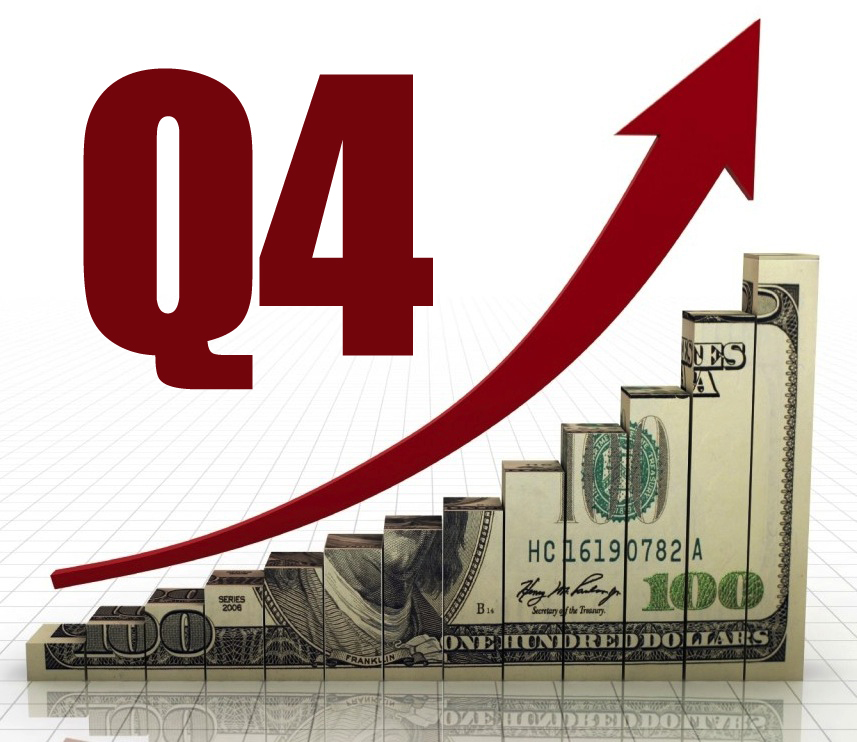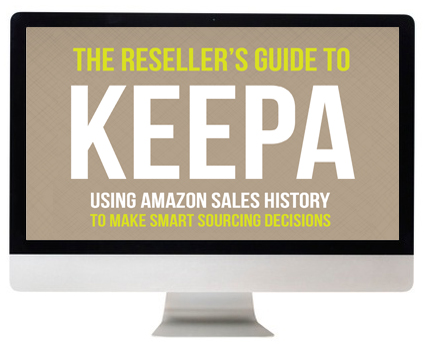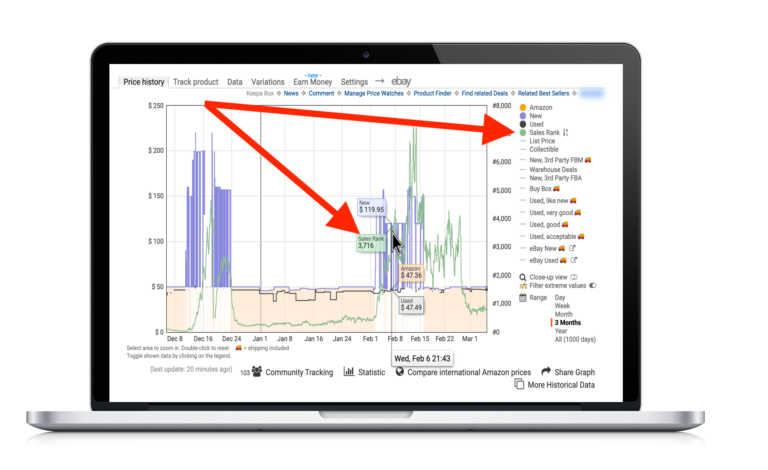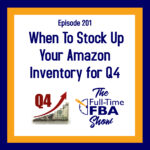It may be the middle of August, but it is not too early to start thinking about how you can take advantage of all the incredible opportunities that Q4 brings for selling on Amazon! Today on The Full-Time FBA Show, we are sharing some tips and tricks for stocking up your Q4 inventory.
Today you’ll find out what Q4 means (and what to expect from Amazon during this time), the importance of avoiding stock-outs, and much more. We also delve into why you should stock up on one-off items right now before sharing four tips for stocking your replenishables (replens). Finally, we share some Keepa resources that can help you with your Q4 Amazon inventory. To make sure that you stock up as best you can so your sales don’t slow down because of stock-outs, listen today!
Listen on the podcast player below.
Like what you hear? Tell a friend… and be sure to leave us a rating and a review. Here’s how.
Key points from Episode 201:
 What Q4 means and what you can expect on Amazon in this business period.
What Q4 means and what you can expect on Amazon in this business period.- Why you want to avoid stock-outs.
- The two types of items you will have in your Q4 inventory.
- Why you want to stock up on one-off items now!
- Four tips for stocking up on your replen items during Q4.
- How Keepa can help you with stocking Amazon items for Q4.
Links and resources mentioned in this episode:
Right-click here and save as to download this episode to your computer.
![]()
 The Reseller’s Guide to Keepa
The Reseller’s Guide to Keepa
Have you heard about Keepa? It’s a tool (with both a free and a paid plan) that can dramatically lower the risk of sourcing inventory items that end up tanking in price. I’m sure you know how it feels to buy an item expecting it to sell for a high price only to see the price tank soon after you send it to Amazon. With using Keepa the right way, you can protect yourself from that happening!
Basically, Keepa tracks the vital data on almost every item on Amazon. It can quickly show me the sales rank history, pricing history, buy box price history, used item history, Amazon in stock history, competitors’ stock levels, and so much more. With Keepa, I can easily look at the data from the past and better know what to expect in the future when it comes to price and sales velocity.
 To find out everything there is to know about using Keepa to make smart sourcing decisions, be sure to check out our course, The Reseller’s Guide to Keepa: Using Amazon Sales History to Make Smart Sourcing Decisions.
To find out everything there is to know about using Keepa to make smart sourcing decisions, be sure to check out our course, The Reseller’s Guide to Keepa: Using Amazon Sales History to Make Smart Sourcing Decisions.
With this course, you’ll make more confident sourcing decisions, better pricing decisions, and you’ll grow your Amazon business to the next level by selling your inventory faster and at higher prices!
Back to the main page for The Full-Time FBA Show
More Episodes from the Full-Time FBA Show podcast:
Don’t miss an upcoming episode! Subscribe, download episodes, and review the Full-Time FBA Show:
-
-
- Subscribe on iTunes
- Follow on Spotify
- Follow on Amazon Music (or just ask Alexa to “play The Full-Time FBA Show podcast”)
- Follow on iHeartRadio
- Subscribe on Podbean
- Subscribe on Podbay
- Subscribe on Podchaser
-
![]()
Episode 201 Transcript:

[INTRODUCTION]
[0:00:01.8] ANNOUNCER: Welcome to The Full-Time FBA Show. In each episode, it’s our goal to help you turn part-time hours into a full-time income, selling almost anything on Amazon. Now, your hosts of the show, Stephen and Rebecca Smotherman.
[WELCOME]
[00:00:20] REBECCA: Hello there and welcome to another episode of The Full-Time FBA Show. Today, we’re going to be talking about when to stock up your inventory for Q4. Are you ready to talk about Q4, Stephen?
[00:00:33] STEPHEN: I am ready for Q4 weather, that’s for sure.
[00:00:35] REBECCA: Oh, for real. This is coming out in August of – the middle of August of 2023. Man, this has been a hot summer.
[00:00:43] STEPHEN: Yes. We’ve had a lot of days in a row of triple digits and I’m dying, even though I’m not dying. It’s just –
[00:00:49] REBECCA: We’re surviving.
[00:00:49] STEPHEN: Yes, we’re surviving. It’s just a little mild suffrage. I don’t know.
[00:00:54] REBECCA: Q4 weather would be great. But what’s even better than Q4 weather is Q4 sales. So, let’s get into this topic for today.
[EPISODE]
[00:01:04] REBECCA: All right, so we need to start thinking about Q4 right now. It’s the middle of August, but it is not too early to start thinking about how you’re going to take advantage of the incredible opportunity that Q4 brings to Amazon sellers, like you and me.
For a quick refresher, Q4 stands for quarter four, or a fourth quarter, and it’s used in the business world, to mean, in the final three months of the year. October, November, and December. So, here’s what you can expect on Amazon. In October, sales will start to rise a little bit. But by the last week of October sales should really start picking up. Then, in November sales can be really, really good and continue to improve from there. Then, in December, the first three weeks are going to be some of the best sales numbers you can expect for the whole year. Those are like really technical terms that I just use. They’re really, really good. I didn’t say super good. But that’s also another technical term. December is usually super good for sales.
[00:02:02] STEPHEN: Yes. And December is a technical term, also for a month. Anyway, I don’t know what I’m talking about. Let’s get back to stuff I do know what I’m talking about, because yes, December can be awesome as long as you still have stuff to sell. I mean, imagine if you sell out in November, and people are still wanting to buy but you’re sold out in December. That’s not good. So, we want to be sure we’re stocked up as best we can so our sales don’t slow down because of stock-outs, which basically means being sold out of the inventory that we’re selling. That leads us to today’s question, when should we start stocking up for Q4? We’re going to give you some of our best tips to think through your Q4 inventory strategy.
[00:02:41] REBECCA: With these Q4 stocking-up tips, we realized that you have two types of items in your inventory. You’re going to have some one-off items that you only have one of, and then replen which you could possibly go deep on, buy multiples of, and send them to Amazon to sell. For those one-off items that you have, just make sure you get those to Amazon as soon as possible. Now, is the time to stock up on your one-off items. If you already have sources for them, or if you find them while you’re outsourcing because why not sell them now? You don’t want to hold onto them. Then, the rest of our tips are going to be for stocking up on your replen items.
[00:03:19] STEPHEN: Yes, so the first tip when thinking about when to stock up for replens, if you find inventory that will sell now, send it to Amazon as soon as possible. I mean get those sales now. Make that money so that you can reinvest that capital into even more inventory as Q4 progresses. Selling now is always a good thing. So, sell as much as you can of these multiples now, to keep reinvesting that capital until more inventory starts to snowball. It’s an awesome thing and you’re going to know if the item you sell now – oh, and if you’re curious, how do I know if it’s going to sell now? Well, you can look at a Keepa graph and have a pretty decent idea of how fast your inventory item is going to sell, how much it’s going to sell for. You can look at a Keepa graph on that. Find out more about Keepa, fulltimefba.com/readkeepa.
[00:04:04] REBECCA: Okay. For our second stocking tip, I just realized stocking is like a pun, Christmas stocking.
[00:04:09] STEPHEN: That’s funny. I love that.
[00:04:11] REBECCA: That was pun unintended. That’s for you, Peter. He loves intended or unintended puns. Back to what I was saying. So, if you’re sending in inventory for holiday-focused sales, think Christmas, Kwanzaa, Hanukkah, any gift-giving holidays that are going to be coming up in these months, be sure that you have it at Amazon, by October. Just be aware that storage fees are going to be almost 4x what you pay the rest of the year during October, November, and December. So, it’s still best to send in the inventory items that are going to sell quickly just knowing that you’ve got to have high enough ROI to cover those fees. As always, you can use Keepa just like Stephen was saying, to make sure that you know what to expect with pricing and sales velocity during those months.
[00:04:58] STEPHEN: The third stocking-up tip, I just love that stocking, is that if you have multiples of the same item, then send in about a month’s worth of sales for that inventory in October, then kind of check on that inventory on how it’s going. Take an assessment mid-October, to see how fast or how slow you’re selling, to see if you need to send in more inventory items or not, so that you can make sure you’re always in stock. It is the worst time of the year to sell out of an inventory item during Q4.
So, we want to make sure that it’s the most wonderful time of the year that you’re always stocked up, so you always want to make sure you’re keeping tabs on your inventory levels, so that come November, you have stock. Mid-November, you still have stuff in stock, and you just keep getting those sales. Just know that November sales velocity speeds up even more as the weeks go by and December goes even faster during those first three weeks of December.
[00:05:53] REBECCA: And then our final tip is when December comes around, don’t stop sending in inventory to Amazon. Product sales are going to slow down at the end of December, but they’re not going to come to a stop. Then, after Christmas and into January, people are going to have those Amazon gift cards that they got as stocking stuffers, or gifts from people, and they’re going to want to spend them as fast as they can. They’re finally going to be buying those things that they didn’t get for the holiday that they wanted all along. Kids are going to start wanting to buy what their friends got for Christmas and parents are going to oblige.
People will be buying on Amazon even after the holidays so you want to be stocked up for those buyers. The sales velocity won’t be quite the same but honestly, we’ve had several years where our January, we sold more in January than we did the December or the month before. So, don’t –
[00:06:46] STEPHEN: Yes. As long as you’re still stocked, you can get those sales.
[00:06:50] REBECCA: Exactly. Don’t sleep on January. January can be a great month.
[00:06:53] STEPHEN: Yes. And a great month to sleep in, also.
[00:06:55] REBECCA: That’s true. Sleep in, in January, but don’t sleep on January.
[00:06:58] STEPHEN: That’s right. Okay, so to kind of summarize everything, you want your inventory to Amazon as soon as possible, if you’ve seen the data that it’s going to sell quickly. And you want your stuff in Amazon warehouses by October, if it’s an item a customer is going to purchase for the holiday, as a gift for the holiday or as a holiday item. So, throughout Q4, it’s always good to keep this mantra on repeat. Source inventory, ship to Amazon, repeat, but I’m not going to repeat it.
Okay, I’ll repeat one more time. Source inventory, ship to Amazon, repeat. Again, the data we’re talking about is found in Keepa. Keepa shows you the pricing history and sales rank history and is an Amazon seller’s best friend when making quality sourcing decisions, quality pricing decisions, and how to know how deep to go on a buy. For more on Keepa, fulltimefba.com/keepa. For a little intro video on how to read a Keepa graph, fulltimefba.com/readkeepa. And if you are just ready, “Stephen, tell me everything you know about Keepa”, fulltimefba.com/keepacourse where we outline everything there is to know and more about Keepa.
[00:08:03] REBECCA: Thank you so much for joining us for this episode of The Full-Time FBA Show. As always, you can find the links that we mentioned. I know there were several related to Keepa in this episode. You can find them in the show notes at fulltime.fba.com/201. This is our 201st episode.
[00:08:21] STEPHEN: Next week on the show, we’re going to talk about how to source a going-out-of-business or store-closing sale successfully. There’s some things you can think about to make sure you take advantage of those situations because yes, every year stores close down, big chain stores close down, and so there might be opportunities near you. We’re going to make sure that you’re ready for those opportunities to make some good money as an Amazon seller with these going-out-of-business sales that are going to make sure you don’t go out of business. We’ll do that next week on The Full-Time FBA Show.
[OUTRO]
[00:08:51] ANNOUNCER: That is all for this episode of The Full-Time FBA Show. So, head over to fulltimefba.com/podcast, where you will find the show notes and links from this episode. While you’re there, subscribe to our newsletter where you’ll get several free downloads of our popular and helpful Amazon FBA resources. Now, take action on what you have learned today so you can find success at turning part-time hours into a full-time income with Amazon FBA.
[END]


Leave a Reply